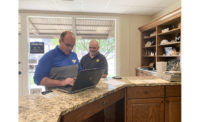Selling and installing security solutions is enough of a challenge under normal circumstances, but a global pandemic can really shake things up. For example, the video management systems (VMS) market was chugging along until COVID-19 reared its ugly head and changed everything.
“Then March came around, and of course, the narrative and the conversations we were having with customers changed significantly,” says Hamish Dobson, senior director, product management, Avigilon, Chicago. “The focus all of a sudden changed into, ‘How do we get our businesses back up and running safely?’”
In addition to the sweeping changes in daily life, one of the biggest security changes was increased requirements for remote viewing and interactivity.
“Many businesses are still operating with remote workers and may have limited staff or no staff on site,” says Brad McMullen, general manager, security products and solutions, STANLEY Electronic Security Solutions, Indianapolis. “The ability to remotely view what is happening on-site is critical.”
The rapid, and in some cases lasting, shift to remote work has created additional challenges for securing premises.
“Our lifestyles have changed very much over the past few months, and so has the work reality,” says Laurent Villeneuve, product marketing manager, Genetec, Montreal. “There’s been a high increase in property and materials theft and vandalism, and trespassing. Empty offices and corporate buildings are very tempting for criminals, so there’s increased risk. Our customers have to adapt very quickly to that, and they might not be ready for this change.”
In the enterprise space, integrators have been asked to solve security challenges that span multiple systems and often multiple locations. Adding to the difficulty is the challenge of demonstrating a viable solution without being at a site.
“COVID-19 has further complicated the integrator’s capability in delivering comprehensive demos and pilots because much of the technology is still being developed,” says Eric Moe, director of sales, North America, Milestone Systems, Copenhagen, Denmark. “For the technology that exists today, it can be difficult for SIs to get their hands on it; demand is really high right now and the market is in a constant state of flux.”
The Role of Training
When integrators work with less familiar technologies, training is a key component. In the past, much of that training was conducted in person, either with a manufacturer sending someone to an end user’s site or hosting a training at their location. While more in-person learning is now possible and permissible around the country, that wasn’t the case early on in the pandemic.
Salient Systems, based in Austin, Texas, took advantage of the changes brought on by COVID-19 to offer integrators online training to learn new skills or sharpen their existing skills.
“As we saw that a lot of these installers were sitting at home twiddling their thumbs because they couldn’t gain access to a facility, we immediately put out a program and let people know we have a product we can actually certify people on with an instructor-led online class so they didn’t have to leave their house,” says Paul Fisher, Salient’s vice president, key and national accounts - global.
The hope is that as installers are able to get back into the field, they can be more efficient and even pass any additional savings on to their customers.
“Hopefully that adds something to the bottom line of these companies, and the investment they made in a small amount of training when their employees were sitting dormant, hopefully paid off for him,” Fisher says.
Installation Consideration
Many of the solutions on the market can be complex to deploy and configure, particularly when end users require a lot of features, says Aaron Saks, product and technical manager, Hanwha Techwin America, Teaneck, N.J.
“Integrators don’t want to be in the building for hours and hours,” he says. “They might be wearing a lot of PPE, which is uncomfortable. They want to get in and get out and make it quick. So, I think one solution is having VMS that … have certain feature sets that can be basic to set up.”
In many cases, organizations are looking beyond their traditional premises when installing video equipment, which can complicate VMS configuration.
“COVID-19 has impacted organizations by requiring them to have fewer people on-site and less staff to support the smaller number of people,” says John Moss, chief product officer, LenelS2, Pittsford, N.Y. “In order to maintain social distancing requirements, there cannot be as many people in a guard force or security operations center. We are starting to see a preference for more equipment that is off-site, accessible off-site or cloud deployed. Integrators should start increasing their expertise in virtual machine and SaaS deployments.”
Remote configuration, which is available in many of the VMS on the market, is another helpful feature with respect to the pandemic. But it isn’t a panacea, says Daniel Gundlach, head of global business development and key accounts, critical infrastructure, FLIR Systems, Arlington, Va.
“With COVID-19, VMS setup and maintenance can be performed remotely and efficiently; however, hardware on-site installation can be both a challenge and an opportunity,” he says. “Maintaining safety during installation, including ensuring social distancing, can slow projects down.”
One of the biggest challenges that integrators face today is making sure they are up to date with pandemic-related equipment, features and solutions.
“Understanding the applications and identifying where these new tools fit in with solving these problems is a challenge due to the pace of this new technology,” says Jammy DeSousa, senior product manager, American Dynamics, Milwaukee.
Protection & Privacy
As seen with Europe’s GDPR regulation, privacy is a major concern in all aspects of life, including security video. And while the U.S. doesn’t have such stringent laws in place at the moment, there will likely be some effort to regulate privacy in the not-too-distant future.
“Privacy is an important issue to consider, especially as VMS systems delve into the health arena tied to preventing the spread of COVID-19. For example, adding elevated skin temperature screening as part of access control raises questions about tracking and storing individual temperature data,” says FLIR’s Daniel Gundlach.
As with any networked technology that creates and transmits data, the first lines of defense must be encryption and security policy.
“For any types of data collection by the VMS — faces, temperature, gender and any other descriptive features — the data must be encrypted and all network interfaces are secured behind a proper firewall,” says James Hoang, partnering and integration manager, Speco Technologies, Amityville, N.Y. “Anyone wishing access to this data must have proper user credentials with a strong password.”
Masking functions are also a possibility, preventing certain areas within a field of view from being seen by obscuring identifiable features. Shortening the amount of time video is retained is another tactic that is often used with VMS.
“Retention time can be shortened to weeks versus months, so the 14-day period of typical virus incubation is still addressed. Also, a video management system can be configured so that temperature readings are not retained in the video system itself,” says John Moss of LenelS2.
While these functions work to protect the video within the system, there are still ways video could be misused.
“The number one way that video is leaking to the internet is people using their cell phones and just recording the screen,” says Aaron Saks of Hanwha Techwin America. “Our VMS offers the ability to burn in a watermark on the screen so if someone is holding a phone, whether it’s live or playback of recorded video, it will have the user’s name listed on the screen. If that video leaks, you’ll know whose account was used to record it.”
New Thinking on Applications
One of the biggest challenges for integrators and providers alike has been changing requirements in the last few months based on an evolving understanding of the pandemic. For example, says Brad Eck, community management program owner, Milestone Systems, the initial spike in technology interest was in thermal skin temperature screening. Since then, technologies have been developed to address social distancing concerns, as well as tracking. As requirements shift, the industry needs to be prepared to pivot as necessary.
“The current buzz is around back-to-school technologies and changes to existing solutions that focus on keeping our children and their teachers safe,” Eck says.
VMS are extending the security concept to also include health safety, Gundlach says.
“Increasingly, customers are augmenting VMS with elevated skin temperature screening thermography cameras and systems, along with analytics appliances such as facial recognition or occupancy control,” he says.
As new features, functions and uses for VMS emerge, one important factor to keep in mind is protecting all the video and data that is collected and analyzed via the software, Grundach says. (See Protection & Privacy Online Sidebar at http://sdmmag.com/articles/98475-protection-privacy.)
“Cyber security continues to be a top issue, and that cannot be lost as customers request new tools and functionality to combat COVID-19,” Grundach says. “This trend is further exacerbated as customers increasingly need flexible remote access and usability for the increased number of remote users —often people working from home as a result of the virus — with a wider variety of profiles and needs.”










